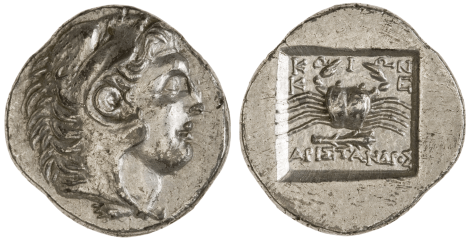
PREV ARTICLE
NEXT ARTICLE
FULL ISSUE
PREV FULL ISSUE
INTERVIEW: KATHERINE VAN SCHAIK
The May 20, 2015 ANS Pocket Change blog, written by Matthew Wittmann, interviews a recent visitor to the society's
collections. Katherine van Schaik is an M.D. and Ph.D. student at Harvard University. Here's an excerpt; the complete interview is
available online. -Editor
And how did you get interested in numismatics? I did my undergraduate degree at Harvard College, so I had interacted with Carmen Arnold-Biucchi at that time. She taught a section on coins for a course I was taking, and the idea she communicated to our section — that you could see and hold something that someone had seen and held and used so long ago — was just incredible to me. And that’s what I really like about coins: the opportunity to do ‘hands-on’ history. What brought you to the ANS today? The breadth and depth of the collection.. Harvard has a fantastic collection and what’s available on the ANS website is great, but being here and actually seeing these trays of coins was transformative. You can see all of the different varieties and changes next to each other. I can look at a coin from a healing sanctuary in Cos and then I can compare it to a coin from Epidaurus. It’s the intensity and immediacy of the comparison that makes for a really fruitful research opportunity. 
Could you talk about a coin that you saw today that you found particularly important? One that I found interesting is this silver drachm from the island of Cos, which had a huge temple to Asclepius and also is supposedly where Hippocrates was born and taught medicine. The word cancer that we use to denote neoplastic growth was used in Greco-Roman antiquity to mean any kind of hardened lump on the body. We’re not sure exactly if it was cancer in the sense that we would understand cancer or if it was an abscess or some other form of swelling. It’s clear that the word (καρκίνος) could mean ‘cancer’ in the sense that we now understand but the term did not apply to this pathological condition exclusively. In a medical context, the word καρκίνος is descriptive, in that its literal meaning is ‘crab’. The image of the crab is very common for coins from the island of Cos, and it is hard to prove this idea, but I do wonder if there is some connection between the iconography of the crab and the idea that one goes to Cos to be healed of the swelling called a καρκίνος. I don’t know if there’s a pun or some kind of link with what happened at the healing sanctuary and the iconography. And it might be something impossible to prove, but its something I am considering in my research at the moment. To read the complete article, see:
Wayne Homren, Editor The Numismatic Bibliomania Society is a non-profit organization promoting numismatic literature. See our web site at coinbooks.org. To submit items for publication in The E-Sylum, write to the Editor at this address: whomren@gmail.com To subscribe go to: https://my.binhost.com/lists/listinfo/esylum All Rights Reserved. NBS Home Page Contact the NBS webmaster 
|